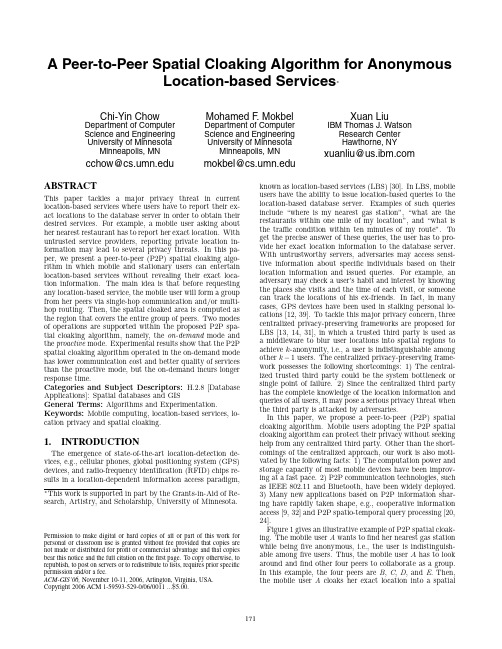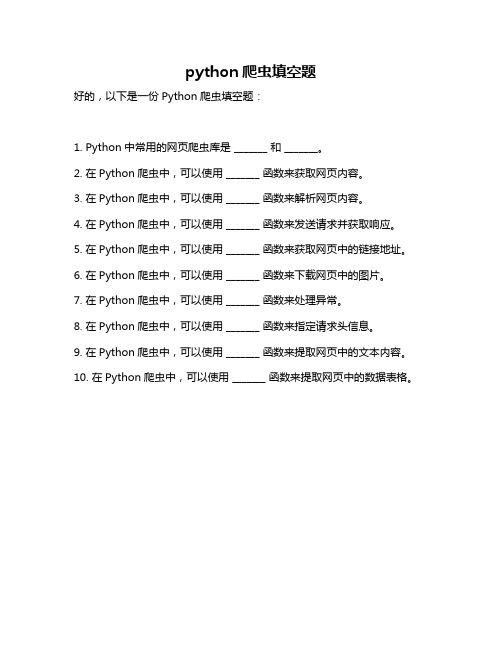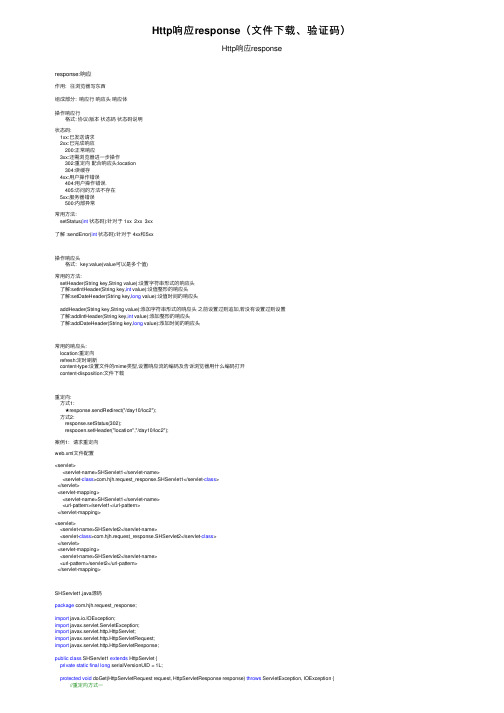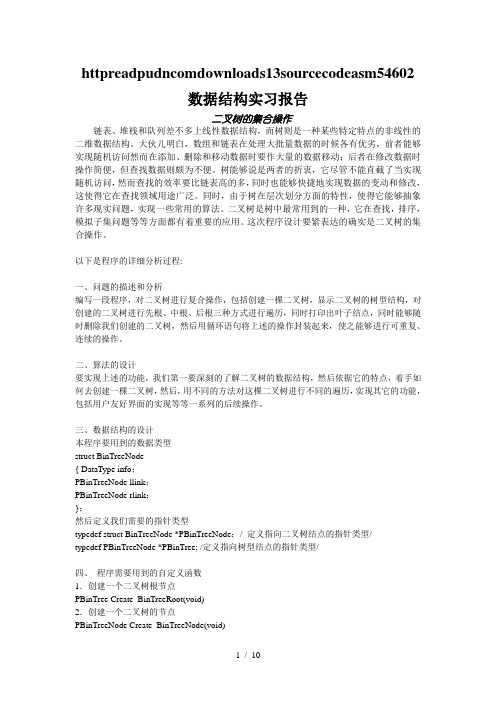httpreadpudncomdownloads142sourcecodeos617955结束版所有内容索创软件项目实习报告ppt
downloads

[JAVA书籍400本,精心收藏].JSP.wljishu.rar.part ed2k://|file|[JAVA%E4%B9%A6%E7%B1%8D400%E6%9C%AC%EF%BC%8C%E7%B2%BE%E5%BF%83%E6%94%B6%E8%97%8F].JSP.wljishu.rar|5285878|F1823C5FE12A0F9B3DCB30D46AE1DB64|/
[JAVA书籍400本,精心收藏].practicalapache(1).rar.part ed2k://|file|[JAVA%E4%B9%A6%E7%B1%8D400%E6%9C%AC%EF%BC%8C%E7%B2%BE%E5%BF%83%E6%94%B6%E8%97%8F].practicalapache(1).rar|4006690|2256967025904344BA4CB28E56126B48|/
C.Sharp.3.0.设计模式.rar.part ed2k://|file|C.Sharp.3.0.%E8%AE%BE%E8%AE%A1%E6%A8%A1%E5%BC%8F.rar|2282207|9EDC0D16697500276928C3B1D2AE9647|/
[JAVA书籍400本,精心收藏].jdbclianji.rar.part ed2k://|file|[JAVA%E4%B9%A6%E7%B1%8D400%E6%9C%AC%EF%BC%8C%E7%B2%BE%E5%BF%83%E6%94%B6%E8%97%8F].jdbclianji.rar|285473|066E22CAA107023C50E710FACDABE71F|/
jsp 实用教程(第二版)程序源代码

<JSP实用教程>(第二版)清华大学出版社(耿祥义张跃平编著)程序源代码建议使用文档结构图浏览使用(选择Word菜单→视图→文档结构图)摘要JSP是一种动态网页技术标准,利用这一技术可以建立安全、跨平台的先进动态网站。
本书是一本实用教程,配备了大量的例题,叙述详细,通俗易懂,便于自学,特别注重结合实例讲解一些难点和关键技术。
全书共分10章,内容包括JSP简介、JSP语法、内置对象、JSP与Javabean、文件操作、数据库操作、JavaServlet、MVC设计模式、JSP中使用XML等重要内容。
本书所有知识都结合具体实例进行介绍.力求详略得当,突出JSP在开发Web动态网站方面的强大功能,使读者快速掌握和运用JSP的编程技巧。
本书不仅可以作为大学计算机及相关专业的选修课教材,也适合自学者及网站开发人员参考使用。
前言本书是《JSP实用教程》的第二版,继续保留原教材的特点——注重教材的可读性和实用性,许多例题都经过精心的考虑,即能帮助理解知识,同时又具有启发性。
在第二版中增加了XML和MVC模式在Web设计中的应用,对全书章节的先后顺序和部分例题的内容做了调整。
第1章介绍JSP重要性,对Tomcat服务器的安装与配置给予了详细介绍。
第2章讲解JSP 页面的基本构成、常用的JSP标记。
第3章讲解内置对象,特别强调了这些内置对象在JSP应用开发中的重要性,结合实例使读者掌握内置对象的用法。
第4章是JSP技术中很重要的内容,即怎样使用Javabean分离数据的显示和处理,这一章讲解了许多有一定应用价值的例子。
第5章主要讲解怎样使用Java中的输入输出流实现文件的读写操作,在实例上特别强调怎样使用Javabean实现文件的读写操作。
第6章涉及的内容是数据库,也是Web应用开发的非常重要的一部分内容,特别介绍了各种数据库的连接方式。
第7章讲解JavaServlet,对servlet对象的运行原理给予了细致的讲解,许多例子都是大多数Web开发中经常使用的模块。
软件著作权源代码

#include <tybs/commandline.h>令狐采学#include <tybs/dir.h>#include <tybs/entropy.h>#include <tybs/file.h>#include <tybs/hash.h>#include <tybs/os.h>#include <tybs/platform.h>#include <tybs/resource.h>#include <tybs/stdio.h>#include <tybs/string.h>#include <tybs/task.h>#include <tybs/timer.h>#include <tybs/util.h>#include <tybscc/result.h>#include <dns/dispatch.h>#include <dns/name.h>#include <dns/result.h>#include <dns/view.h>#include <dst/result.h>#define NS_MAIN 1#include <named/ns_smf_globals.h> #endif#ifdef DLZ#include <dlz/dlz_drivers.h>#endifstatic tybs_boolean_t want_stats = TYBS_FALSE;static char program_name[TYBS_DIR_NAMEMAX] = "named"; static char absolute_conffile[TYBS_DIR_PATHMAX];static char saved_command_line[512];static char version[512];static unsigned int maxsocks = 0;voidns_main_earlywarning(const char *format, ...) {va_list args;va_start(args, format);if (ns_g_lctx != NULL) {tybs_log_vwrite(ns_g_lctx, NS_LOGCATEGORY_GENERAL,NS_LOGMODULE_MAIN,TYBS_LOG_WARNING,format, args);} else {fprintf(stderr, "%s: ", program_name);vfprintf(stderr, format, args);fprintf(stderr, "\n");fflush(stderr);}va_end(args);}Voidns_main_earlyfatal(const char *format, ...) {va_list args;va_start(args, format);if (ns_g_lctx != NULL) {tybs_log_vwrite(ns_g_lctx, NS_LOGCATEGORY_GENERAL,NS_LOGMODULE_MAIN,TYBS_LOG_CRITICAL,format, args);tybs_log_write(ns_g_lctx, NS_LOGCATEGORY_GENERAL,NS_LOGMODULE_MAIN,TYBS_LOG_CRITICAL,"exiting (due to early fatal error)");} else {fprintf(stderr, "%s: ", program_name);vfprintf(stderr, format, args);fprintf(stderr, "\n");fflush(stderr);}va_end(args);exit(1);}static voidassertion_failed(const char *file, int line, tybs_assertiontype_t type,const char *cond){if (ns_g_lctx != NULL) {tybs_assertion_setcallback(NULL);tybs_log_write(ns_g_lctx, NS_LOGCATEGORY_GENERAL,NS_LOGMODULE_MAIN,TYBS_LOG_CRITICAL,"%s:%d: %s(%s) failed", file, line,tybs_assertion_typetotext(type), cond);tybs_log_write(ns_g_lctx, NS_LOGCATEGORY_GENERAL,NS_LOGMODULE_MAIN,TYBS_LOG_CRITICAL,"exiting (due to assertion failure)");} else {fprintf(stderr, "%s:%d: %s(%s) failed\n",file, line, tybs_assertion_typetotext(type), cond);fflush(stderr);}if (ns_g_coreok)abort();exit(1);}static voidlibrary_fatal_error(const char *file, int line, const char *format,va_list args) TYBS_FORMAT_PRINTF(3, 0); static voidlibrary_fatal_error(const char *file, int line, const char *format, va_list args){if (ns_g_lctx != NULL) {tybs_error_setfatal(NULL);tybs_log_write(ns_g_lctx, NS_LOGCATEGORY_GENERAL,NS_LOGMODULE_MAIN,TYBS_LOG_CRITICAL,"%s:%d: fatal error:", file, line);tybs_log_vwrite(ns_g_lctx, NS_LOGCATEGORY_GENERAL,NS_LOGMODULE_MAIN,TYBS_LOG_CRITICAL,format, args);tybs_log_write(ns_g_lctx, NS_LOGCATEGORY_GENERAL,NS_LOGMODULE_MAIN,TYBS_LOG_CRITICAL,"exiting (due to fatal error in library)");} else {fprintf(stderr, "%s:%d: fatal error: ", file, line);vfprintf(stderr, format, args);fprintf(stderr, "\n");fflush(stderr);}if (ns_g_coreok)abort();exit(1);}static voidlibrary_unexpected_error(const char *file, int line, const char *format, va_list args) TYBS_FORMAT_PRINTF(3, 0);static voidlibrary_unexpected_error(const char *file, int line, const char *format, va_list args){if (ns_g_lctx != NULL) {tybs_log_write(ns_g_lctx, NS_LOGCATEGORY_GENERAL,NS_LOGMODULE_MAIN,TYBS_LOG_ERROR,"%s:%d: unexpected error:", file, line);tybs_log_vwrite(ns_g_lctx, NS_LOGCATEGORY_GENERAL,NS_LOGMODULE_MAIN,TYBS_LOG_ERROR,format, args);} else {fprintf(stderr, "%s:%d: fatal error: ", file, line);vfprintf(stderr, format, args);fprintf(stderr, "\n");fflush(stderr);}}static voidlwresd_usage(void) {fprintf(stderr,"usage: lwresd [-4|-6] [-c conffile | -C resolvconffile] ""[-d debuglevel]\n"" [-f|-g] [-n number_of_cpus] [-p port] ""[-P listen-port] [-s]\n"" [-t chrootdir] [-u username] [-i pidfile]\n"" [-m {usage|trace|record|size|mctx}]\n"); }static voidusage(void) {if (ns_g_lwresdonly) {lwresd_usage();return;}fprintf(stderr,"usage: named [-4|-6] [-c conffile] [-d debuglevel] ""[-f|-g] [-n number_of_cpus]\n"" [-p port] [-s] [-t chrootdir] [-u username]\n"" [-m {usage|trace|record|size|mctx}]\n"); }static voidsave_command_line(int argc, char *argv[]) {int i;char *src;char *dst;char *eob;const char truncated[] = "...";tybs_boolean_t quoted = TYBS_FALSE;dst = saved_command_line;eob = saved_command_line + sizeof(saved_command_line);for (i = 1; i < argc && dst < eob; i++) {*dst++ = ' ';src = argv[i];while (*src != '\0' && dst < eob) {if (quoted || isalnum(*src & 0xff) ||*src == '-' || *src == '_' ||*src == '.' || *src == '/') {*dst++ = *src++;quoted = TYBS_FALSE;} else {*dst++ = '\\';quoted = TYBS_TRUE;}}}INSIST(sizeof(saved_command_line) >= sizeof(truncated));if (dst == eob)strcpy(eob - sizeof(truncated), truncated);else*dst = '\0';}static intparse_int(char *arg, const char *desc) {char *endp;int tmp;long int ltmp;ltmp = strtol(arg, &endp, 10);tmp = (int) ltmp;if (*endp != '\0')ns_main_earlyfatal("%s '%s' must be numeric", desc, arg);if (tmp < 0 || tmp != ltmp)ns_main_earlyfatal("%s '%s' out of range", desc, arg);return (tmp);}static struct flag_def {const char *name;unsigned int value;} mem_debug_flags[] = {{ "trace", TYBS_MEM_DEBUGTRACE },{ "record", TYBS_MEM_DEBUGRECORD },{ "usage", TYBS_MEM_DEBUGUSAGE },{ "size", TYBS_MEM_DEBUGSIZE },{ "mctx", TYBS_MEM_DEBUGCTX },{ NULL, 0 }};static voidset_flags(const char *arg, struct flag_def *defs, unsigned int *ret) { for (;;) {const struct flag_def *def;const char *end = strchr(arg, ',');int arglen;if (end == NULL)end = arg + strlen(arg);arglen = end - arg;for (def = defs; def->name != NULL; def++) {if (arglen == (int)strlen(def->name) &&memcmp(arg, def->name, arglen) == 0) {*ret |= def->value;goto found;}}ns_main_earlyfatal("unrecognized flag '%.*s'", arglen, arg);found:if (*end == '\0')break;arg = end + 1;}}static voidparse_command_line(int argc, char *argv[]) {int ch;int port;tybs_boolean_t disable6 = TYBS_FALSE;tybs_boolean_t disable4 = TYBS_FALSE;save_command_line(argc, argv);tybs_commandline_errprint = TYBS_FALSE;while ((ch = tybs_commandline_parse(argc, argv,"46c:C:d:fgi:lm:n:N:p:P:""sS:t:T:u:vVx:")) != -1) {switch (ch) {case '4':if (disable4)ns_main_earlyfatal("cannot specify -4 and -6");if (tybs_net_probeipv4() != TYBS_R_SUCCESS)ns_main_earlyfatal("IPv4 not supported by OS"); tybs_net_disableipv6();disable6 = TYBS_TRUE;break;case '6':if (disable6)ns_main_earlyfatal("cannot specify -4 and -6");if (tybs_net_probeipv6() != TYBS_R_SUCCESS)ns_main_earlyfatal("IPv6 not supported by OS"); tybs_net_disableipv4();disable4 = TYBS_TRUE;break;case 'c':ns_g_conffile = tybs_commandline_argument;lwresd_g_conffile = tybs_commandline_argument;if (lwresd_g_useresolvconf)ns_main_earlyfatal("cannot specify -c and -C");ns_g_conffileset = TYBS_TRUE;break;case 'C':lwresd_g_resolvconffile = tybs_commandline_argument;if (ns_g_conffileset)ns_main_earlyfatal("cannot specify -c and -C");lwresd_g_useresolvconf = TYBS_TRUE;break;case 'd':ns_g_debuglevel = parse_int(tybs_commandline_argument,"debug level");break;case 'f':ns_g_foreground = TYBS_TRUE;break;case 'g':ns_g_foreground = TYBS_TRUE;ns_g_logstderr = TYBS_TRUE;break;/* XXXBEW -i should be removed */case 'i':lwresd_g_defaultpidfile = tybs_commandline_argument;break;case 'l':ns_g_lwresdonly = TYBS_TRUE;break;case 'm':set_flags(tybs_commandline_argument, mem_debug_flags, &tybs_mem_debugging);break;case 'N': /* Deprecated. */ns_g_cpus = parse_int(tybs_commandline_argument,"number of cpus");if (ns_g_cpus == 0)ns_g_cpus = 1;break;case 'p':port = parse_int(tybs_commandline_argument, "port");if (port < 1 || port > 65535)ns_main_earlyfatal("port '%s' out of range",tybs_commandline_argument);ns_g_port = port;break;/* XXXBEW Should -P be removed? */case 'P':port = parse_int(tybs_commandline_argument, "port");if (port < 1 || port > 65535)ns_main_earlyfatal("port '%s' out of range",tybs_commandline_argument);lwresd_g_listenport = port;break;case 's':want_stats = TYBS_TRUE;break;maxsocks = parse_int(tybs_commandline_argument,"max number of sockets");break;case 't':ns_g_chrootdir = tybs_commandline_argument;break;case 'T':if (strcmp(tybs_commandline_argument, "clienttest") == 0) ns_g_clienttest = TYBS_TRUE;elsefprintf(stderr, "unknown -T flag '%s\n",tybs_commandline_argument);break;case 'u':ns_g_username = tybs_commandline_argument;break;case 'v':printf("BIND %s\n", ns_g_version);exit(0);case 'V':printf("BIND %s built with %s\n", ns_g_version,ns_g_configargs);exit(0);usage();if (tybs_commandline_option == '?')exit(0);ns_main_earlyfatal("unknown option '-%c'",tybs_commandline_option);default:ns_main_earlyfatal("parsing options returned %d", ch);}}argc -= tybs_commandline_index;argv += tybs_commandline_index;if (argc > 0) {usage();ns_main_earlyfatal("extra command line arguments");}}static tybs_result_tcreate_managers(void) {tybs_result_t result;unsigned int socks;#ifdef TYBS_PLATFORM_USETHREADSunsigned int cpus_detected;#endif#ifdef TYBS_PLATFORM_USETHREADScpus_detected = tybs_os_ncpus();if (ns_g_cpus == 0)ns_g_cpus = cpus_detected;tybs_log_write(ns_g_lctx, NS_LOGCATEGORY_GENERAL, NS_LOGMODULE_SERVER,TYBS_LOG_INFO, "found %u CPU%s, using %u worker thread%s", cpus_detected, cpus_detected == 1 ? "" : "s",ns_g_cpus, ns_g_cpus == 1 ? "" : "s");#elsens_g_cpus = 1;#endifresult = tybs_taskmgr_create(ns_g_mctx, ns_g_cpus, 0, &ns_g_taskmgr);if (result != TYBS_R_SUCCESS) {UNEXPECTED_ERROR(__FILE__, __LINE__,"tybs_taskmgr_create() failed: %s",tybs_result_totext(result));return (TYBS_R_UNEXPECTED);}result = tybs_timermgr_create(ns_g_mctx, &ns_g_timermgr);if (result != TYBS_R_SUCCESS) {UNEXPECTED_ERROR(__FILE__, __LINE__,"tybs_timermgr_create() failed: %s",tybs_result_totext(result));return (TYBS_R_UNEXPECTED);}result = tybs_socketmgr_create2(ns_g_mctx, &ns_g_socketmgr, maxsocks);if (result != TYBS_R_SUCCESS) {UNEXPECTED_ERROR(__FILE__, __LINE__,"tybs_socketmgr_create() failed: %s",tybs_result_totext(result));return (TYBS_R_UNEXPECTED);}result = tybs_socketmgr_getmaxsockets(ns_g_socketmgr, &socks);if (result == TYBS_R_SUCCESS) {tybs_log_write(ns_g_lctx, NS_LOGCATEGORY_GENERAL,NS_LOGMODULE_SERVER,TYBS_LOG_INFO, "using up to %u sockets", socks);}result = tybs_entropy_create(ns_g_mctx, &ns_g_entropy);if (result != TYBS_R_SUCCESS) {UNEXPECTED_ERROR(__FILE__, __LINE__,"tybs_entropy_create() failed: %s",tybs_result_totext(result));return (TYBS_R_UNEXPECTED);}result = tybs_hash_create(ns_g_mctx, ns_g_entropy, DNS_NAME_MAXWIRE);if (result != TYBS_R_SUCCESS) {UNEXPECTED_ERROR(__FILE__, __LINE__,"tybs_hash_create() failed: %s",tybs_result_totext(result));return (TYBS_R_UNEXPECTED);}return (TYBS_R_SUCCESS);}static voiddestroy_managers(void) {ns_lwresd_shutdown();tybs_entropy_detach(&ns_g_entropy);if (ns_g_fallbackentropy != NULL)tybs_entropy_detach(&ns_g_fallbackentropy);tybs_taskmgr_destroy(&ns_g_taskmgr);tybs_timermgr_destroy(&ns_g_timermgr);tybs_socketmgr_destroy(&ns_g_socketmgr);tybs_hash_destroy();}static voidsetup(void) {tybs_result_t result;#ifdef HAVE_LIBSCFchar *instance = NULL;#endifns_os_inituserinfo(ns_g_username);ns_os_tzset();ns_os_opendevnull();#ifdef HAVE_LIBSCFresult = ns_smf_get_instance(&instance, 0, ns_g_mctx);if (result == TYBS_R_SUCCESS)ns_smf_got_instance = 1;elsens_smf_got_instance = 0;if (instance != NULL)tybs_mem_free(ns_g_mctx, instance);#endif /* HAVE_LIBSCF */#ifdef PATH_RANDOMDEVif (ns_g_chrootdir != NULL) {result = tybs_entropy_create(ns_g_mctx, &ns_g_fallbackentropy);if (result != TYBS_R_SUCCESS)ns_main_earlyfatal("tybs_entropy_create() failed: %s",tybs_result_totext(result));result = tybs_entropy_createfilesource(ns_g_fallbackentropy,PATH_RANDOMDEV);if (result != TYBS_R_SUCCESS) {ns_main_earlywarning("could not open pre-chroot ""entropy source %s: %s",PATH_RANDOMDEV,tybs_result_totext(result));tybs_entropy_detach(&ns_g_fallbackentropy);}}#endifns_os_chroot(ns_g_chrootdir);ns_os_minprivs();result = ns_log_init(TYBS_TF(ns_g_username != NULL));if (result != TYBS_R_SUCCESS)ns_main_earlyfatal("ns_log_init() failed: %s",tybs_result_totext(result));if (!ns_g_foreground)ns_os_daemonize();result = tybs_app_start();if (result != TYBS_R_SUCCESS)ns_main_earlyfatal("tybs_app_start() failed: %s",tybs_result_totext(result));tybs_log_write(ns_g_lctx, NS_LOGCATEGORY_GENERAL, NS_LOGMODULE_MAIN,TYBS_LOG_NOTICE, "starting BIND %s%s", ns_g_version,saved_command_line);tybs_log_write(ns_g_lctx, NS_LOGCATEGORY_GENERAL, NS_LOGMODULE_MAIN,TYBS_LOG_NOTICE, "built with %s", ns_g_configargs);(void)tybs_resource_getlimit(tybs_resource_stacksize,&ns_g_initstacksize);(void)tybs_resource_getlimit(tybs_resource_datasize,&ns_g_initdatasize);(void)tybs_resource_getlimit(tybs_resource_coresize,&ns_g_initcoresize);(void)tybs_resource_getlimit(tybs_resource_openfiles,&ns_g_initopenfiles);if (! tybs_file_isabsolute(ns_g_conffile)) {result = tybs_file_absolutepath(ns_g_conffile,absolute_conffile,sizeof(absolute_conffile));if (result != TYBS_R_SUCCESS)ns_main_earlyfatal("could not construct absolute path of ""configuration file: %s",tybs_result_totext(result));ns_g_conffile = absolute_conffile;}result = tybs_time_now(&ns_g_boottime);if (result != TYBS_R_SUCCESS)ns_main_earlyfatal("tybs_time_now() failed: %s", tybs_result_totext(result));result = create_managers();if (result != TYBS_R_SUCCESS)ns_main_earlyfatal("create_managers() failed: %s", tybs_result_totext(result));ns_builtin_init();#ifdef DLZresult = dlz_drivers_init();if (result != TYBS_R_SUCCESS)ns_main_earlyfatal("dlz_drivers_init() failed: %s", tybs_result_totext(result));#endifns_server_create(ns_g_mctx, &ns_g_server);}static voidcleanup(void) {destroy_managers();ns_server_destroy(&ns_g_server);ns_builtin_deinit();#ifdef DLZdlz_drivers_clear();#endifdns_name_destroy();tybs_log_write(ns_g_lctx, NS_LOGCATEGORY_GENERAL, NS_LOGMODULE_MAIN,TYBS_LOG_NOTICE, "exiting");ns_log_shutdown();}static char *memstats = NULL;voidns_main_setmemstats(const char *filename) {if (memstats != NULL) {free(memstats);memstats = NULL;}if (filename == NULL)return;memstats = malloc(strlen(filename) + 1);if (memstats)strcpy(memstats, filename);}#ifdef HAVE_LIBSCFtybs_result_tns_smf_get_instance(char **ins_name, int debug, tybs_mem_t *mctx) {scf_handle_t *h = NULL;int namelen;char *instance;REQUIRE(ins_name != NULL && *ins_name == NULL); if ((h = scf_handle_create(SCF_VERSION)) == NULL) { if (debug)UNEXPECTED_ERROR(__FILE__, __LINE__,"scf_handle_create() failed: %s",scf_strerror(scf_error()));return (TYBS_R_FAILURE);}if (scf_handle_bind(h) == -1) {if (debug)UNEXPECTED_ERROR(__FILE__, __LINE__,"scf_handle_bind() failed: %s",scf_strerror(scf_error()));scf_handle_destroy(h);return (TYBS_R_FAILURE);}if ((namelen = scf_myname(h, NULL, 0)) == -1) { if (debug)UNEXPECTED_ERROR(__FILE__, __LINE__,"scf_myname() failed: %s",scf_strerror(scf_error()));scf_handle_destroy(h);return (TYBS_R_FAILURE);if ((instance = tybs_mem_allocate(mctx, namelen + 1)) == NULL) {UNEXPECTED_ERROR(__FILE__, __LINE__,"ns_smf_get_instance memory ""allocation failed: %s",tybs_result_totext(TYBS_R_NOMEMORY));scf_handle_destroy(h);return (TYBS_R_FAILURE);}if (scf_myname(h, instance, namelen + 1) == -1) {if (debug)UNEXPECTED_ERROR(__FILE__, __LINE__,"scf_myname() failed: %s",scf_strerror(scf_error()));scf_handle_destroy(h);tybs_mem_free(mctx, instance);return (TYBS_R_FAILURE);}scf_handle_destroy(h);*ins_name = instance;return (TYBS_R_SUCCESS);}#endifmain(int argc, char *argv[]) {tybs_result_t result;#ifdef HAVE_LIBSCFchar *instance = NULL;#endifstrlcat(version,#ifdef __DATE__"named version: BIND " VERSION " (" __DATE__ ")",#else"named version: BIND " VERSION,#endifsizeof(version));result = tybs_file_progname(*argv, program_name, sizeof(program_name));if (result != TYBS_R_SUCCESS)ns_main_earlyfatal("program name too long");if (strcmp(program_name, "lwresd") == 0)ns_g_lwresdonly = TYBS_TRUE;tybs_assertion_setcallback(assertion_failed);tybs_error_setfatal(library_fatal_error);tybs_error_setunexpected(library_unexpected_error);ns_os_init(program_name);dns_result_register();tybscc_result_register();parse_command_line(argc, argv);if (ns_g_chrootdir != NULL) {int len = strlen(ns_g_chrootdir);if (strncmp(ns_g_chrootdir, ns_g_conffile, len) == 0 &&(ns_g_conffile[len] == '/' || ns_g_conffile[len] == '\\'))ns_main_earlywarning("config filename (-c %s) contains ""chroot path (-t %s)",ns_g_conffile, ns_g_chrootdir);}result = tybs_mem_create(0, 0, &ns_g_mctx);if (result != TYBS_R_SUCCESS)ns_main_earlyfatal("tybs_mem_create() failed: %s",tybs_result_totext(result));tybs_mem_setname(ns_g_mctx, "main", NULL);setup();do {result = tybs_app_run();if (result == TYBS_R_RELOAD) {ns_server_reloadwanted(ns_g_server);} else if (result != TYBS_R_SUCCESS) {UNEXPECTED_ERROR(__FILE__, __LINE__,"tybs_app_run(): %s",result = TYBS_R_SUCCESS;}} while (result != TYBS_R_SUCCESS);#ifdef HAVE_LIBSCFif (ns_smf_want_disable == 1) {result = ns_smf_get_instance(&instance, 1, ns_g_mctx);if (result == TYBS_R_SUCCESS && instance != NULL) { if (smf_disable_instance(instance, 0) != 0)UNEXPECTED_ERROR(__FILE__, __LINE__,"smf_disable_instance() ""failed for %s : %s",instance,scf_strerror(scf_error()));}if (instance != NULL)tybs_mem_free(ns_g_mctx, instance);}#endif /* HAVE_LIBSCF */cleanup();if (want_stats) {tybs_mem_stats(ns_g_mctx, stdout);tybs_mutex_stats(stdout);}if (ns_g_memstatistics && memstats != NULL) {FILE *fp = NULL;result = tybs_stdio_open(memstats, "w", &fp);if (result == TYBS_R_SUCCESS) {tybs_mem_stats(ns_g_mctx, fp);tybs_mutex_stats(fp);tybs_stdio_close(fp);}}tybs_mem_destroy(&ns_g_mctx);tybs_mem_checkdestroyed(stderr);ns_main_setmemstats(NULL);tybs_app_finish();ns_os_closedevnull();ns_os_shutdown();return (0);}#define ZEND_INCLUDE_FULL_WINDOWS_HEADERS #include "php.h"#include <stdio.h>#include <fcntl.h>#ifdef PHP_WIN32#include "win32/time.h"#include "win32/signal.h"#include "win32/php_win32_globals.h" #include <process.h>#elif defined(NETWARE)#include <sys/timeval.h>#ifdef USE_WINSOCK#include <novsock2.h>#endif#endif#if HAVE_SYS_TIME_H#include <sys/time.h>#endif#if HAVE_UNISTD_H#include <unistd.h>#endif#if HAVE_SIGNAL_H#include <signal.h>#endif#if HAVE_SETLOCALE#include <locale.h>#endif#include "zend.h"#include "zend_extensions.h"#include "php_ini.h"#include "php_globals.h"#include "fopen_wrappers.h"#include "ext/standard/php_standard.h" #include "php_variables.h"#include "ext/standard/credits.h"#ifdef PHP_WIN32#include <io.h>#include "win32/php_registry.h"#include "ext/standard/flock_compat.h" #endif#include "php_syslog.h"#include "Zend/zend_exceptions.h"#if PHP_SIGCHILD#include <sys/types.h>#include <sys/wait.h>#endif#include "zend_compile.h"#include "zend_execute.h"#include "zend_highlight.h"#include "zend_indent.h"#include "zend_extensions.h"#include "zend_ini.h"#include "php_content_types.h"#include "php_ticks.h"#include "php_streams.h"#include "php_open_temporary_file.h" #include "SAPI.h"#include "rfc1867.h"/* }}} */#ifndef ZTSphp_core_globals core_globals;#elsePHPAPI int core_globals_id;#endif#define SAFE_FILENAME(f) ((f)?(f):"-") /* {{{ PHP_INI_MH*/static PHP_INI_MH(OnSetPrecision){int i = atoi(new_value);if (i >= 0) {EG(precision) = i;return SUCCESS;} else {return FAILURE;}}static PHP_INI_MH(OnChangeMemoryLimit){if (new_value) {PG(memory_limit) = zend_atoi(new_value, new_value_length);} else {PG(memory_limit) = 1<<30; /* effectively, no limit */ }return zend_set_memory_limit(PG(memory_limit));}static void php_disable_functions(TSRMLS_D){char *s = NULL, *e;if (!*(INI_STR("disable_functions"))) {return;}e = PG(disable_functions) = strdup(INI_STR("disable_functions"));while (*e) {switch (*e) {case ' ':case ',':if (s) {*e = '\0';zend_disable_function(s, e-s TSRMLS_CC);s = NULL;}break;default:if (!s) {s = e;}break;}e++;}if (s) {zend_disable_function(s, e-s TSRMLS_CC);}}static void php_disable_classes(TSRMLS_D){char *s = NULL, *e;if (!*(INI_STR("disable_classes"))) {return;}e = PG(disable_classes) = strdup(INI_STR("disable_classes"));while (*e) {switch (*e) {case ' ':case ',':if (s) {*e = '\0';zend_disable_class(s, e-s TSRMLS_CC);s = NULL;}break;default:if (!s) {s = e;}break;}e++;}if (s) {zend_disable_class(s, e-s TSRMLS_CC);}}static PHP_INI_MH(OnUpdateTimeout){EG(timeout_seconds) = atoi(new_value);if (stage==PHP_INI_STAGE_STARTUP) {/* Don't set a timeout on startup, only per-request */return SUCCESS;}zend_unset_timeout(TSRMLS_C);zend_set_timeout(EG(timeout_seconds));return SUCCESS;}static int php_get_display_errors_mode(char *value, int value_length) {int mode;if (!value) {return PHP_DISPLAY_ERRORS_STDOUT;}if (value_length == 2 && !strcasecmp("on", value)) {mode = PHP_DISPLAY_ERRORS_STDOUT;} else if (value_length == 3 && !strcasecmp("yes", value)) { mode = PHP_DISPLAY_ERRORS_STDOUT;} else if (value_length == 4 && !strcasecmp("true", value)) { mode = PHP_DISPLAY_ERRORS_STDOUT;} else if (value_length == 6 && !strcasecmp(value, "stderr")) { mode = PHP_DISPLAY_ERRORS_STDERR;} else if (value_length == 6 && !strcasecmp(value, "stdout")) { mode = PHP_DISPLAY_ERRORS_STDOUT;} else {mode = atoi(value);if (mode && mode != PHP_DISPLAY_ERRORS_STDOUT && mode != PHP_DISPLAY_ERRORS_STDERR) {mode = PHP_DISPLAY_ERRORS_STDOUT;}}return mode;}static PHP_INI_MH(OnUpdateDisplayErrors){PG(display_errors) = (zend_bool) php_get_display_errors_mode(new_value, new_value_length);return SUCCESS;}static PHP_INI_DISP(display_errors_mode){int mode, tmp_value_length, cgi_or_cli;char *tmp_value;TSRMLS_FETCH();if (type == ZEND_INI_DISPLAY_ORIG && ini_entry->modified) {tmp_value = (ini_entry->orig_value ? ini_entry->orig_value : NULL );tmp_value_length = ini_entry->orig_value_length;} else if (ini_entry->value) {tmp_value = ini_entry->value;tmp_value_length = ini_entry->value_length;} else {tmp_value = NULL;tmp_value_length = 0;}mode = php_get_display_errors_mode(tmp_value, tmp_value_length);cgi_or_cli = (!strcmp(sapi_, "cli") || !strcmp(sapi_, "cgi"));switch (mode) {case PHP_DISPLAY_ERRORS_STDERR:if (cgi_or_cli ) {PUTS("STDERR");} else {PUTS("On");}break;case PHP_DISPLAY_ERRORS_STDOUT:if (cgi_or_cli ) {PUTS("STDOUT");} else {PUTS("On");}break;default:PUTS("Off");break;}}static PHP_INI_MH(OnUpdateErrorLog){/* Only do the safemode/open_basedir check at runtime */if ((stage == PHP_INI_STAGE_RUNTIME || stage == PHP_INI_STAGE_HTACCESS) &&strcmp(new_value, "syslog")) {if (PG(safe_mode) && (!php_checkuid(new_value, NULL, CHECKUID_CHECK_FILE_AND_DIR))) {return FAILURE;}if (PG(open_basedir) && php_check_open_basedir(new_value TSRMLS_CC)) {return FAILURE;}}OnUpdateString(entry, new_value, new_value_length, mh_arg1, mh_arg2, mh_arg3, stage TSRMLS_CC);。
httpreadpudncomdownloads120sourcecodemath511293例题与总结ppt

0 x 1 y 2
(3)求单元II常数
ai x j ym xm y j ab a j xm yi xi ym ab a x y x y ab i j j i m
bi y j ym a b j ym yi 0 b y y a i j m
单元 II
m
i II j
bi 1
ai x j y m x m y j
bi y j y m
j m i
ci x j x m
bm 1
ci 0
(2-17)
cm 2
bj 0
c j 2
ci bj c j bm cm bi E II b S ci b j cj bm cm i 21 2 A 1 c 1 b 1 c 1 b 1 c 1 b i j j m m 2 i 2 2 2 2 2
9 求单元应力 单元 I
S I
{ }e S { }e
e
1 2 9E 1 8 6 0
0 0 1 6
0 0 1 3
1 3 1 0
1 2 1 6 1 3
1 3 1 1 6
j I
I
i
m
1 2 P 9E 1 Et 8 6 0
0 1 a 1 b
1 E D 2 1 0
1 b E I S DB 2 1 b 0 0 0 1 2b
0 1 0 1 0 2
0 0 1 2a
1 1 br bs 2 cr c s br c s 2 cr bs Eh [k rs ] [ Br ]T [ D][ Bs ]hA 4(1 2 ) A c b 1 b c c c 1 b b r s r s r s r s 2 2
常见编译错误解析ppt课件

常见编译器错误提示(三)
Conversion may lose significant digits -----------------转换时会丢失意义的数字 Conversion of near pointer not allowed -----------------不允许转换近指针 Could not find file ‘’xxx‘’ -----------------------找不到XXX文件 Declaration missing ; ----------------说明缺少";“ Declaration syntax error -----------------说明中出现语法错误 Default outside of switch ------------------ Default 出现在switch语句之外 Define directive needs an identifier ------------------定义编译预处理需要标识符 Division by zero ------------------用零作除数 Do statement must have while ------------------ Do-while语句中缺少while部分 Enum syntax error ---------------------枚举类型语法错误
常见编译器错误提示(五)
Hexadecimal or octal constant too large ------------------16进制或8进制常数太大 Illegal character ''x'' ------------------非法字符x Illegal initialization ------------------非法的初始化 Illegal octal digit ------------------非法的8进制数字 Illegal pointer subtraction ------------------非法的指针相减 Illegal stru----非法的结构体操作 Illegal use of floating point -----------------非法的浮点运算 Illegal use of pointer --------------------指针使用非法 Improper use of a typedefsymbol ----------------类型定义符号使用不恰当 In-line assembly not allowed -----------------不允许使用行间汇编
httpreadpudncomdownloads15ebook57923循环链表doc

#ifndef CircList_H
#define CircList_H
include "List.h"
template <class Type> class CircList : public List<Type>
{
public:
CircList() { pGetFirst()->link = pGetFirst(); }
1. 构造函数:派生类实例化时,先调用基类的构造函数;因此,初始化循环链表的工作就是将带表头的空链表的表头节点的link指向表头节点,从而构成一个圈。
2. 析构函数:释放对象时,先调用派生类的析构函数,然后调用基类的析构函数。因此,释放循环链表只需要将循环链表变成普通的单链表,然后这个单链表会被基类的析构函数释放。这里假定不使用这种语句Base *p = new Drived;delete p;因为我在~List()前面没有加virtual。你可以参阅各种C++书籍搞清这类问题。
{
pGetFirst()->data = value;
List<Type>::Find(value);
if (pGet() == pGetFirst()) return FALSE;
return TURE;
}
* Locate原来的实现在这里其实也没什么语义的毛病,无非是转圈吗,当然怎么改随你。建议配合Length检查定位值的合法,这样可以把转圈提前扼杀。
说是一个旅行社要从n名旅客中选出一名幸运旅客,为他提供免费环球旅行服务。方法是,大家站成圈,然后选定一个m,从第1个人开始报数,报到m时,这个人OUT,然后从下一个人开始重新从1报数,重复这个过程,直到最后剩下一个人就是幸运之星。问题就是谁是幸运者呢?或者说是怎样才能赢大奖。
常见错误代码提示解决方案

常见错误代码提示解决方案在编程的过程中,我们经常会遇到各种各样的错误代码提示,这些提示往往会让我们感到困惑和烦恼。
为了帮助大家更好地解决常见错误代码提示,本文将为大家提供一些解决方案。
1. NullPointerException(空指针异常)空指针异常通常是由于访问了一个空对象的属性或方法所引起的。
解决这个问题的办法是在使用对象之前先进行判空处理,可以通过使用if语句进行判断,或者使用Java 8中引入的Optional类来避免空指针异常的发生。
2. SyntaxError(语法错误)语法错误是指代码中存在不符合语法规则的表达式或语句。
解决这个问题的方法是仔细检查代码,查找可能存在的拼写错误、缺少分号等语法错误,并对其进行修正。
3. IndexError(索引错误)索引错误通常发生在访问列表或数组时,索引超出了范围。
解决这个问题的办法是确保索引在有效的范围内,可以通过使用len()函数获取列表或数组的长度,并进行合理的判断和处理。
4. ValueError(数值错误)数值错误通常是由于对数据类型的转换或计算出现问题。
解决这个问题的方法是确保数据的类型正确,并进行适当的类型转换。
此外,还可以使用try-except语句来捕获数值错误,并给出相应的提示或处理方法。
5. FileNotFoundError(文件未找到错误)文件未找到错误通常发生在读取或操作文件时,指定的文件路径不正确或文件不存在。
解决这个问题的办法是检查文件路径是否正确,并确保文件存在。
同时,还可以使用try-except语句来捕获文件未找到错误,并进行相应的处理。
6. AttributeError(属性错误)属性错误通常是指访问了一个对象不存在的属性。
解决这个问题的方法是确认对象拥有该属性,并进行相应的处理。
可以使用dir()函数来查看对象的属性列表,或者使用hasattr()函数来判断对象是否拥有指定的属性。
7. ImportError(导入错误)导入错误通常发生在导入模块时,模块不存在或路径错误。
J2EE开发基础(习题卷3)

J2EE开发基础(习题卷3)第1部分:单项选择题,共59题,每题只有一个正确答案,多选或少选均不得分。
1.[单选题]下面哪一项不是JDBC的工作任务?A)与数据库建立连接B)操作数据库,处理数据库返回的结果C)在网页中生成表格D)向数据库管理系统发送SQL语句答案:C解析:2.[单选题]视图解析器配置文件,横线处<beanclass="org.springframework.web.servlet.view.InternalResourceViewResolver"> </property></property></bean>应该填写什么?A)*/B)prefixC)srefixD)答案:B解析:3.[单选题]test.jsp 文件如下:<%buffer.append("ABC");%>Buffer is <%=buffer%>试图运行时,将发生()A)编译期错误B)编译Servlet 源码时发生错误C)运行Servlet 时发生错误D)运行后,浏览器上显示: buffer isABC答案:A解析:4.[单选题]下面关于Java 语言特点的描述中,错误的是( )。
A)Java是纯面向对象编程语言,支持单继承和多继承。
B)Java支持分布式的网络应用,可透明地访问网络上的其他对象。
C)Java支持多线程D)Java程序与平台无关、可移植性好。
答案:A解析:5.[单选题]在Spring 配置文件中定义了“ bookServiceTarget ”和通知“ logAdvice ”, 然后定义代理类“ bookService ”, 则以下说法错误的是( )。
( 选择一项)<beans><bean id="bookServiceTarget" class="com.accp.aop.BookServiceImpl"/><bean id="logAdvice" class="com.accp.aop.LogAdvice"/><bean id="bookService"class="org.springframework.aop.framwork.ProxyFactoryBean"><property name="proxyInterfaces"><value>com.accp.aop6BookService</value></property><list><value>com.accp.aop6BookService</value></list></property><property name="target" ref="bookServiceTarget"/></bean></beans>A)通过直接访问bookServiceTarget , logAdvice 中的代码将会被执行B)为了实现前置通知, LogAdvice 需实现MethodBeforeAdvice 接口C)interceporName 指定织入的通知列表,其中<value> 节点可以有多个D)<property name="proxyInterfaces"><value>com.accp.aop.BookService</value></property>可以写成<property name="proxyInterfaces"value="com.acp.aop.BookService">答案:D解析:6.[单选题]@Aspect注解的作用是?A)作用是把当前类标识为一个切面B)标识一个前置增强方法C)标识一个后置增强类D)标识一个动态代理类答案:A解析:7.[单选题]messageorg.bob.taglib.MessageTagemptynametrue对这段配置描述正确的是A)定义了一个message 标签,有一个属性叫nameB)配置了一个名字为message 的标签,该名称对应到org.bob.taglib.MessageTag 类,并且标签不允许有主体内容,使用标签时有一个必须得属性为nameC)声明了一个名字为message 的标签,该标签对应到MessageTag 类,并且标签没有主体内容D)标签配置错误,主体不能为空答案:B解析:8.[单选题]下列选项中不属于服务器端动态网页技术的是( )A)ASPB)JSPC)JavaScriptD)PHP答案:C解析:9.[单选题]阅读以下PL/SQL 程序:1 begin2 for idx in 1..10 loop3 dbms_output.put_line( ‘Index= ’||idx) ;4 End loop5 end以下说法正确的是( )。
jsp练习题(打印版)

jsp练习题(打印版)### JSP 练习题题目一:JSP 基础1. 简述 JSP 的全称及其主要作用。
2. 描述 JSP 页面的基本结构。
3. 列举 JSP 中常用的内置对象,并简述它们的作用。
题目二:JSP 脚本元素1. 编写一个 JSP 页面,使用 scriptlet 打印出当前日期和时间。
2. 描述 JSP 中的表达式(Expression)和声明(Declaration)的区别。
3. 给出一个使用 JSP 表达式输出变量值的示例。
题目三:JSP 指令1. 解释 JSP 中的 page 指令和 include 指令的区别。
2. 编写一个使用 include 指令的 JSP 页面,将头部和尾部信息包含进来。
3. 描述 taglib 指令的作用,并给出一个使用它的示例。
题目四:JSP 动作元素1. 描述 JSP 中的 forward 动作元素的作用。
2. 编写一个使用 forward 动作元素将请求转发到另一个 JSP 页面的示例。
3. 列举 JSP 中的常用动作元素,并简述它们的用途。
题目五:JSP 数据库操作1. 编写一个 JSP 页面,使用 JDBC 连接数据库,并查询数据库中的用户信息。
2. 描述在 JSP 页面中处理数据库查询结果的一般步骤。
3. 给出一个使用 JSP 显示数据库查询结果的示例。
题目六:JSP 会话管理1. 描述 JSP 中的 session 对象的作用。
2. 编写一个 JSP 页面,使用 session 对象存储用户登录信息。
3. 描述 session 对象的生命周期,并给出一个使用 session 存储和获取信息的示例。
题目七:JSP 错误处理1. 描述 JSP 页面中的错误页面(errorPage)的作用。
2. 编写一个 JSP 页面,当发生错误时,能够将用户重定向到错误页面。
3. 描述 JSP 页面中的错误代码和异常类型的关系。
题目八:JSP 过滤器1. 描述 JSP 过滤器(filter)的作用。
httpdownload54545

start to InternetWriteFile dwBufLen = 10240, m_hHttpFile = 13369360
InternetWriteFile return TRUE
start to InternetWriteFile dwBufLen = 10240, m_hHttpFile = 13369360
InternetWriteFile return TRUE
start to InternetWriteFile dwBufLen = 2156, m_hHttpFile = 13369368
InternetWriteFile return TRUE
start to InternetWriteFile dwBufLen = 16, m_hHttpFile = 13369368
before OpenInternetConnection m_hHttpConnect : 0
after OpenInternetConnection m_hHttpConnect : 13369356
OpenSaveFile : d:\Program Files\Tencent\QQ\Plugin\Com.Tencent.Qzone\bin\QQPhotoDrawEx\Tencent\QQPhotoDrawEx\ULStrategyUpload.{3A6906B5-9FE0-408C-B43C-B6D338B00B71}.180445564.0, dwError = 0, m_hSaveFileHandle = 4872
IsAsyncIOSucceeded dwError = 997
ACM-GIS%202006-A%20Peer-to-Peer%20Spatial%20Cloaking%20Algorithm%20for%20Anonymous%20Location-based%

A Peer-to-Peer Spatial Cloaking Algorithm for AnonymousLocation-based Services∗Chi-Yin Chow Department of Computer Science and Engineering University of Minnesota Minneapolis,MN cchow@ Mohamed F.MokbelDepartment of ComputerScience and EngineeringUniversity of MinnesotaMinneapolis,MNmokbel@Xuan LiuIBM Thomas J.WatsonResearch CenterHawthorne,NYxuanliu@ABSTRACTThis paper tackles a major privacy threat in current location-based services where users have to report their ex-act locations to the database server in order to obtain their desired services.For example,a mobile user asking about her nearest restaurant has to report her exact location.With untrusted service providers,reporting private location in-formation may lead to several privacy threats.In this pa-per,we present a peer-to-peer(P2P)spatial cloaking algo-rithm in which mobile and stationary users can entertain location-based services without revealing their exact loca-tion information.The main idea is that before requesting any location-based service,the mobile user will form a group from her peers via single-hop communication and/or multi-hop routing.Then,the spatial cloaked area is computed as the region that covers the entire group of peers.Two modes of operations are supported within the proposed P2P spa-tial cloaking algorithm,namely,the on-demand mode and the proactive mode.Experimental results show that the P2P spatial cloaking algorithm operated in the on-demand mode has lower communication cost and better quality of services than the proactive mode,but the on-demand incurs longer response time.Categories and Subject Descriptors:H.2.8[Database Applications]:Spatial databases and GISGeneral Terms:Algorithms and Experimentation. Keywords:Mobile computing,location-based services,lo-cation privacy and spatial cloaking.1.INTRODUCTIONThe emergence of state-of-the-art location-detection de-vices,e.g.,cellular phones,global positioning system(GPS) devices,and radio-frequency identification(RFID)chips re-sults in a location-dependent information access paradigm,∗This work is supported in part by the Grants-in-Aid of Re-search,Artistry,and Scholarship,University of Minnesota. Permission to make digital or hard copies of all or part of this work for personal or classroom use is granted without fee provided that copies are not made or distributed for profit or commercial advantage and that copies bear this notice and the full citation on thefirst page.To copy otherwise,to republish,to post on servers or to redistribute to lists,requires prior specific permission and/or a fee.ACM-GIS’06,November10-11,2006,Arlington,Virginia,USA. Copyright2006ACM1-59593-529-0/06/0011...$5.00.known as location-based services(LBS)[30].In LBS,mobile users have the ability to issue location-based queries to the location-based database server.Examples of such queries include“where is my nearest gas station”,“what are the restaurants within one mile of my location”,and“what is the traffic condition within ten minutes of my route”.To get the precise answer of these queries,the user has to pro-vide her exact location information to the database server. With untrustworthy servers,adversaries may access sensi-tive information about specific individuals based on their location information and issued queries.For example,an adversary may check a user’s habit and interest by knowing the places she visits and the time of each visit,or someone can track the locations of his ex-friends.In fact,in many cases,GPS devices have been used in stalking personal lo-cations[12,39].To tackle this major privacy concern,three centralized privacy-preserving frameworks are proposed for LBS[13,14,31],in which a trusted third party is used as a middleware to blur user locations into spatial regions to achieve k-anonymity,i.e.,a user is indistinguishable among other k−1users.The centralized privacy-preserving frame-work possesses the following shortcomings:1)The central-ized trusted third party could be the system bottleneck or single point of failure.2)Since the centralized third party has the complete knowledge of the location information and queries of all users,it may pose a serious privacy threat when the third party is attacked by adversaries.In this paper,we propose a peer-to-peer(P2P)spatial cloaking algorithm.Mobile users adopting the P2P spatial cloaking algorithm can protect their privacy without seeking help from any centralized third party.Other than the short-comings of the centralized approach,our work is also moti-vated by the following facts:1)The computation power and storage capacity of most mobile devices have been improv-ing at a fast pace.2)P2P communication technologies,such as IEEE802.11and Bluetooth,have been widely deployed.3)Many new applications based on P2P information shar-ing have rapidly taken shape,e.g.,cooperative information access[9,32]and P2P spatio-temporal query processing[20, 24].Figure1gives an illustrative example of P2P spatial cloak-ing.The mobile user A wants tofind her nearest gas station while beingfive anonymous,i.e.,the user is indistinguish-able amongfive users.Thus,the mobile user A has to look around andfind other four peers to collaborate as a group. In this example,the four peers are B,C,D,and E.Then, the mobile user A cloaks her exact location into a spatialA B CDEBase Stationregion that covers the entire group of mobile users A ,B ,C ,D ,and E .The mobile user A randomly selects one of the mobile users within the group as an agent .In the ex-ample given in Figure 1,the mobile user D is selected as an agent.Then,the mobile user A sends her query (i.e.,what is the nearest gas station)along with her cloaked spa-tial region to the agent.The agent forwards the query to the location-based database server through a base station.Since the location-based database server processes the query based on the cloaked spatial region,it can only give a list of candidate answers that includes the actual answers and some false positives.After the agent receives the candidate answers,it forwards the candidate answers to the mobile user A .Finally,the mobile user A gets the actual answer by filtering out all the false positives.The proposed P2P spatial cloaking algorithm can operate in two modes:on-demand and proactive .In the on-demand mode,mobile clients execute the cloaking algorithm when they need to access information from the location-based database server.On the other side,in the proactive mode,mobile clients periodically look around to find the desired number of peers.Thus,they can cloak their exact locations into spatial regions whenever they want to retrieve informa-tion from the location-based database server.In general,the contributions of this paper can be summarized as follows:1.We introduce a distributed system architecture for pro-viding anonymous location-based services (LBS)for mobile users.2.We propose the first P2P spatial cloaking algorithm for mobile users to entertain high quality location-based services without compromising their privacy.3.We provide experimental evidence that our proposed algorithm is efficient in terms of the response time,is scalable to large numbers of mobile clients,and is effective as it provides high-quality services for mobile clients without the need of exact location information.The rest of this paper is organized as follows.Section 2highlights the related work.The system model of the P2P spatial cloaking algorithm is presented in Section 3.The P2P spatial cloaking algorithm is described in Section 4.Section 5discusses the integration of the P2P spatial cloak-ing algorithm with privacy-aware location-based database servers.Section 6depicts the experimental evaluation of the P2P spatial cloaking algorithm.Finally,Section 7con-cludes this paper.2.RELATED WORKThe k -anonymity model [37,38]has been widely used in maintaining privacy in databases [5,26,27,28].The main idea is to have each tuple in the table as k -anonymous,i.e.,indistinguishable among other k −1tuples.Although we aim for the similar k -anonymity model for the P2P spatial cloaking algorithm,none of these techniques can be applied to protect user privacy for LBS,mainly for the following four reasons:1)These techniques preserve the privacy of the stored data.In our model,we aim not to store the data at all.Instead,we store perturbed versions of the data.Thus,data privacy is managed before storing the data.2)These approaches protect the data not the queries.In anonymous LBS,we aim to protect the user who issues the query to the location-based database server.For example,a mobile user who wants to ask about her nearest gas station needs to pro-tect her location while the location information of the gas station is not protected.3)These approaches guarantee the k -anonymity for a snapshot of the database.In LBS,the user location is continuously changing.Such dynamic be-havior calls for continuous maintenance of the k -anonymity model.(4)These approaches assume a unified k -anonymity requirement for all the stored records.In our P2P spatial cloaking algorithm,k -anonymity is a user-specified privacy requirement which may have a different value for each user.Motivated by the privacy threats of location-detection de-vices [1,4,6,40],several research efforts are dedicated to protect the locations of mobile users (e.g.,false dummies [23],landmark objects [18],and location perturbation [10,13,14]).The most closed approaches to ours are two centralized spatial cloaking algorithms,namely,the spatio-temporal cloaking [14]and the CliqueCloak algorithm [13],and one decentralized privacy-preserving algorithm [23].The spatio-temporal cloaking algorithm [14]assumes that all users have the same k -anonymity requirements.Furthermore,it lacks the scalability because it deals with each single request of each user individually.The CliqueCloak algorithm [13]as-sumes a different k -anonymity requirement for each user.However,since it has large computation overhead,it is lim-ited to a small k -anonymity requirement,i.e.,k is from 5to 10.A decentralized privacy-preserving algorithm is proposed for LBS [23].The main idea is that the mobile client sends a set of false locations,called dummies ,along with its true location to the location-based database server.However,the disadvantages of using dummies are threefold.First,the user has to generate realistic dummies to pre-vent the adversary from guessing its true location.Second,the location-based database server wastes a lot of resources to process the dummies.Finally,the adversary may esti-mate the user location by using cellular positioning tech-niques [34],e.g.,the time-of-arrival (TOA),the time differ-ence of arrival (TDOA)and the direction of arrival (DOA).Although several existing distributed group formation al-gorithms can be used to find peers in a mobile environment,they are not designed for privacy preserving in LBS.Some algorithms are limited to only finding the neighboring peers,e.g.,lowest-ID [11],largest-connectivity (degree)[33]and mobility-based clustering algorithms [2,25].When a mo-bile user with a strict privacy requirement,i.e.,the value of k −1is larger than the number of neighboring peers,it has to enlist other peers for help via multi-hop routing.Other algorithms do not have this limitation,but they are designed for grouping stable mobile clients together to facil-Location-based Database ServerDatabase ServerDatabase ServerFigure 2:The system architectureitate efficient data replica allocation,e.g.,dynamic connec-tivity based group algorithm [16]and mobility-based clus-tering algorithm,called DRAM [19].Our work is different from these approaches in that we propose a P2P spatial cloaking algorithm that is dedicated for mobile users to dis-cover other k −1peers via single-hop communication and/or via multi-hop routing,in order to preserve user privacy in LBS.3.SYSTEM MODELFigure 2depicts the system architecture for the pro-posed P2P spatial cloaking algorithm which contains two main components:mobile clients and location-based data-base server .Each mobile client has its own privacy profile that specifies its desired level of privacy.A privacy profile includes two parameters,k and A min ,k indicates that the user wants to be k -anonymous,i.e.,indistinguishable among k users,while A min specifies the minimum resolution of the cloaked spatial region.The larger the value of k and A min ,the more strict privacy requirements a user needs.Mobile users have the ability to change their privacy profile at any time.Our employed privacy profile matches the privacy re-quirements of mobiles users as depicted by several social science studies (e.g.,see [4,15,17,22,29]).In this architecture,each mobile user is equipped with two wireless network interface cards;one of them is dedicated to communicate with the location-based database server through the base station,while the other one is devoted to the communication with other peers.A similar multi-interface technique has been used to implement IP multi-homing for stream control transmission protocol (SCTP),in which a machine is installed with multiple network in-terface cards,and each assigned a different IP address [36].Similarly,in mobile P2P cooperation environment,mobile users have a network connection to access information from the server,e.g.,through a wireless modem or a base station,and the mobile users also have the ability to communicate with other peers via a wireless LAN,e.g.,IEEE 802.11or Bluetooth [9,24,32].Furthermore,each mobile client is equipped with a positioning device, e.g.,GPS or sensor-based local positioning systems,to determine its current lo-cation information.4.P2P SPATIAL CLOAKINGIn this section,we present the data structure and the P2P spatial cloaking algorithm.Then,we describe two operation modes of the algorithm:on-demand and proactive .4.1Data StructureThe entire system area is divided into grid.The mobile client communicates with each other to discover other k −1peers,in order to achieve the k -anonymity requirement.TheAlgorithm 1P2P Spatial Cloaking:Request Originator m 1:Function P2PCloaking-Originator (h ,k )2://Phase 1:Peer searching phase 3:The hop distance h is set to h4:The set of discovered peers T is set to {∅},and the number ofdiscovered peers k =|T |=05:while k <k −1do6:Broadcast a FORM GROUP request with the parameter h (Al-gorithm 2gives the response of each peer p that receives this request)7:T is the set of peers that respond back to m by executingAlgorithm 28:k =|T |;9:if k <k −1then 10:if T =T then 11:Suspend the request 12:end if 13:h ←h +1;14:T ←T ;15:end if 16:end while17://Phase 2:Location adjustment phase 18:for all T i ∈T do19:|mT i .p |←the greatest possible distance between m and T i .pby considering the timestamp of T i .p ’s reply and maximum speed20:end for21://Phase 3:Spatial cloaking phase22:Form a group with k −1peers having the smallest |mp |23:h ←the largest hop distance h p of the selected k −1peers 24:Determine a grid area A that covers the entire group 25:if A <A min then26:Extend the area of A till it covers A min 27:end if28:Randomly select a mobile client of the group as an agent 29:Forward the query and A to the agentmobile client can thus blur its exact location into a cloaked spatial region that is the minimum grid area covering the k −1peers and itself,and satisfies A min as well.The grid area is represented by the ID of the left-bottom and right-top cells,i.e.,(l,b )and (r,t ).In addition,each mobile client maintains a parameter h that is the required hop distance of the last peer searching.The initial value of h is equal to one.4.2AlgorithmFigure 3gives a running example for the P2P spatial cloaking algorithm.There are 15mobile clients,m 1to m 15,represented as solid circles.m 8is the request originator,other black circles represent the mobile clients received the request from m 8.The dotted circles represent the commu-nication range of the mobile client,and the arrow represents the movement direction.Algorithms 1and 2give the pseudo code for the request originator (denoted as m )and the re-quest receivers (denoted as p ),respectively.In general,the algorithm consists of the following three phases:Phase 1:Peer searching phase .The request origina-tor m wants to retrieve information from the location-based database server.m first sets h to h ,a set of discovered peers T to {∅}and the number of discovered peers k to zero,i.e.,|T |.(Lines 3to 4in Algorithm 1).Then,m broadcasts a FORM GROUP request along with a message sequence ID and the hop distance h to its neighboring peers (Line 6in Algorithm 1).m listens to the network and waits for the reply from its neighboring peers.Algorithm 2describes how a peer p responds to the FORM GROUP request along with a hop distance h and aFigure3:P2P spatial cloaking algorithm.Algorithm2P2P Spatial Cloaking:Request Receiver p1:Function P2PCloaking-Receiver(h)2://Let r be the request forwarder3:if the request is duplicate then4:Reply r with an ACK message5:return;6:end if7:h p←1;8:if h=1then9:Send the tuple T=<p,(x p,y p),v maxp ,t p,h p>to r10:else11:h←h−1;12:Broadcast a FORM GROUP request with the parameter h 13:T p is the set of peers that respond back to p14:for all T i∈T p do15:T i.h p←T i.h p+1;16:end for17:T p←T p∪{<p,(x p,y p),v maxp ,t p,h p>};18:Send T p back to r19:end ifmessage sequence ID from another peer(denoted as r)that is either the request originator or the forwarder of the re-quest.First,p checks if it is a duplicate request based on the message sequence ID.If it is a duplicate request,it sim-ply replies r with an ACK message without processing the request.Otherwise,p processes the request based on the value of h:Case1:h= 1.p turns in a tuple that contains its ID,current location,maximum movement speed,a timestamp and a hop distance(it is set to one),i.e.,< p,(x p,y p),v max p,t p,h p>,to r(Line9in Algorithm2). Case2:h> 1.p decrements h and broadcasts the FORM GROUP request with the updated h and the origi-nal message sequence ID to its neighboring peers.p keeps listening to the network,until it collects the replies from all its neighboring peers.After that,p increments the h p of each collected tuple,and then it appends its own tuple to the collected tuples T p.Finally,it sends T p back to r (Lines11to18in Algorithm2).After m collects the tuples T from its neighboring peers, if m cannotfind other k−1peers with a hop distance of h,it increments h and re-broadcasts the FORM GROUP request along with a new message sequence ID and h.m repeatedly increments h till itfinds other k−1peers(Lines6to14in Algorithm1).However,if mfinds the same set of peers in two consecutive broadcasts,i.e.,with hop distances h and h+1,there are not enough connected peers for m.Thus, m has to relax its privacy profile,i.e.,use a smaller value of k,or to be suspended for a period of time(Line11in Algorithm1).Figures3(a)and3(b)depict single-hop and multi-hop peer searching in our running example,respectively.In Fig-ure3(a),the request originator,m8,(e.g.,k=5)canfind k−1peers via single-hop communication,so m8sets h=1. Since h=1,its neighboring peers,m5,m6,m7,m9,m10, and m11,will not further broadcast the FORM GROUP re-quest.On the other hand,in Figure3(b),m8does not connect to k−1peers directly,so it has to set h>1.Thus, its neighboring peers,m7,m10,and m11,will broadcast the FORM GROUP request along with a decremented hop dis-tance,i.e.,h=h−1,and the original message sequence ID to their neighboring peers.Phase2:Location adjustment phase.Since the peer keeps moving,we have to capture the movement between the time when the peer sends its tuple and the current time. For each received tuple from a peer p,the request originator, m,determines the greatest possible distance between them by an equation,|mp |=|mp|+(t c−t p)×v max p,where |mp|is the Euclidean distance between m and p at time t p,i.e.,|mp|=(x m−x p)2+(y m−y p)2,t c is the currenttime,t p is the timestamp of the tuple and v maxpis the maximum speed of p(Lines18to20in Algorithm1).In this paper,a conservative approach is used to determine the distance,because we assume that the peer will move with the maximum speed in any direction.If p gives its movement direction,m has the ability to determine a more precise distance between them.Figure3(c)illustrates that,for each discovered peer,the circle represents the largest region where the peer can lo-cate at time t c.The greatest possible distance between the request originator m8and its discovered peer,m5,m6,m7, m9,m10,or m11is represented by a dotted line.For exam-ple,the distance of the line m8m 11is the greatest possible distance between m8and m11at time t c,i.e.,|m8m 11|. Phase3:Spatial cloaking phase.In this phase,the request originator,m,forms a virtual group with the k−1 nearest peers,based on the greatest possible distance be-tween them(Line22in Algorithm1).To adapt to the dynamic network topology and k-anonymity requirement, m sets h to the largest value of h p of the selected k−1 peers(Line15in Algorithm1).Then,m determines the minimum grid area A covering the entire group(Line24in Algorithm1).If the area of A is less than A min,m extends A,until it satisfies A min(Lines25to27in Algorithm1). Figure3(c)gives the k−1nearest peers,m6,m7,m10,and m11to the request originator,m8.For example,the privacy profile of m8is(k=5,A min=20cells),and the required cloaked spatial region of m8is represented by a bold rectan-gle,as depicted in Figure3(d).To issue the query to the location-based database server anonymously,m randomly selects a mobile client in the group as an agent(Line28in Algorithm1).Then,m sendsthe query along with the cloaked spatial region,i.e.,A,to the agent(Line29in Algorithm1).The agent forwards thequery to the location-based database server.After the serverprocesses the query with respect to the cloaked spatial re-gion,it sends a list of candidate answers back to the agent.The agent forwards the candidate answer to m,and then mfilters out the false positives from the candidate answers. 4.3Modes of OperationsThe P2P spatial cloaking algorithm can operate in twomodes,on-demand and proactive.The on-demand mode:The mobile client only executesthe algorithm when it needs to retrieve information from the location-based database server.The algorithm operatedin the on-demand mode generally incurs less communica-tion overhead than the proactive mode,because the mobileclient only executes the algorithm when necessary.However,it suffers from a longer response time than the algorithm op-erated in the proactive mode.The proactive mode:The mobile client adopting theproactive mode periodically executes the algorithm in back-ground.The mobile client can cloak its location into a spa-tial region immediately,once it wants to communicate withthe location-based database server.The proactive mode pro-vides a better response time than the on-demand mode,but it generally incurs higher communication overhead and giveslower quality of service than the on-demand mode.5.ANONYMOUS LOCATION-BASEDSERVICESHaving the spatial cloaked region as an output form Algo-rithm1,the mobile user m sends her request to the location-based server through an agent p that is randomly selected.Existing location-based database servers can support onlyexact point locations rather than cloaked regions.In or-der to be able to work with a spatial region,location-basedservers need to be equipped with a privacy-aware queryprocessor(e.g.,see[29,31]).The main idea of the privacy-aware query processor is to return a list of candidate answerrather than the exact query answer.Then,the mobile user m willfilter the candidate list to eliminate its false positives andfind its exact answer.The tighter the spatial cloaked re-gion,the lower is the size of the candidate answer,and hencethe better is the performance of the privacy-aware query processor.However,tight cloaked regions may represent re-laxed privacy constrained.Thus,a trade-offbetween the user privacy and the quality of service can be achieved[31]. Figure4(a)depicts such scenario by showing the data stored at the server side.There are32target objects,i.e., gas stations,T1to T32represented as black circles,the shaded area represents the spatial cloaked area of the mo-bile client who issued the query.For clarification,the actual mobile client location is plotted in Figure4(a)as a black square inside the cloaked area.However,such information is neither stored at the server side nor revealed to the server. The privacy-aware query processor determines a range that includes all target objects that are possibly contributing to the answer given that the actual location of the mobile client could be anywhere within the shaded area.The range is rep-resented as a bold rectangle,as depicted in Figure4(b).The server sends a list of candidate answers,i.e.,T8,T12,T13, T16,T17,T21,and T22,back to the agent.The agent next for-(a)Server Side(b)Client SideFigure4:Anonymous location-based services wards the candidate answers to the requesting mobile client either through single-hop communication or through multi-hop routing.Finally,the mobile client can get the actualanswer,i.e.,T13,byfiltering out the false positives from thecandidate answers.The algorithmic details of the privacy-aware query proces-sor is beyond the scope of this paper.Interested readers are referred to[31]for more details.6.EXPERIMENTAL RESULTSIn this section,we evaluate and compare the scalabilityand efficiency of the P2P spatial cloaking algorithm in boththe on-demand and proactive modes with respect to the av-erage response time per query,the average number of mes-sages per query,and the size of the returned candidate an-swers from the location-based database server.The queryresponse time in the on-demand mode is defined as the timeelapsed between a mobile client starting to search k−1peersand receiving the candidate answers from the agent.On theother hand,the query response time in the proactive mode is defined as the time elapsed between a mobile client startingto forward its query along with the cloaked spatial regionto the agent and receiving the candidate answers from theagent.The simulation model is implemented in C++usingCSIM[35].In all the experiments in this section,we consider an in-dividual random walk model that is based on“random way-point”model[7,8].At the beginning,the mobile clientsare randomly distributed in a spatial space of1,000×1,000square meters,in which a uniform grid structure of100×100cells is constructed.Each mobile client randomly chooses itsown destination in the space with a randomly determined speed s from a uniform distribution U(v min,v max).When the mobile client reaches the destination,it comes to a stand-still for one second to determine its next destination.Afterthat,the mobile client moves towards its new destinationwith another speed.All the mobile clients repeat this move-ment behavior during the simulation.The time interval be-tween two consecutive queries generated by a mobile client follows an exponential distribution with a mean of ten sec-onds.All the experiments consider one half-duplex wirelesschannel for a mobile client to communicate with its peers with a total bandwidth of2Mbps and a transmission range of250meters.When a mobile client wants to communicate with other peers or the location-based database server,it has to wait if the requested channel is busy.In the simulated mobile environment,there is a centralized location-based database server,and one wireless communication channel between the location-based database server and the mobile。
python爬虫填空题

python爬虫填空题
好的,以下是一份Python爬虫填空题:
1. Python中常用的网页爬虫库是 _______ 和 _______。
2. 在Python爬虫中,可以使用 _______ 函数来获取网页内容。
3. 在Python爬虫中,可以使用 _______ 函数来解析网页内容。
4. 在Python爬虫中,可以使用 _______ 函数来发送请求并获取响应。
5. 在Python爬虫中,可以使用 _______ 函数来获取网页中的链接地址。
6. 在Python爬虫中,可以使用 _______ 函数来下载网页中的图片。
7. 在Python爬虫中,可以使用 _______ 函数来处理异常。
8. 在Python爬虫中,可以使用 _______ 函数来指定请求头信息。
9. 在Python爬虫中,可以使用 _______ 函数来提取网页中的文本内容。
10. 在Python爬虫中,可以使用 _______ 函数来提取网页中的数据表格。
Http响应response(文件下载、验证码)

Http响应response(⽂件下载、验证码)Http响应responseresponse:响应作⽤: 往浏览器写东西组成部分: 响应⾏响应头响应体操作响应⾏格式: 协议/版本状态码状态码说明状态码:1xx:已发送请求2xx:已完成响应200:正常响应3xx:还需浏览器进⼀步操作302:重定向配合响应头:location304:读缓存4xx:⽤户操作错误404:⽤户操作错误.405:访问的⽅法不存在5xx:服务器错误500:内部异常常⽤⽅法:setStatus(int状态码):针对于 1xx 2xx 3xx了解 :sendError(int状态码):针对于 4xx和5xx操作响应头 格式: key:value(value可以是多个值)常⽤的⽅法:setHeader(String key,String value):设置字符串形式的响应头了解:setIntHeader(String key,int value):设值整形的响应头了解:setDateHeader(String key,long value):设值时间的响应头addHeader(String key,String value):添加字符串形式的响应头之前设置过则追加,若没有设置过则设置了解:addIntHeader(String key,int value):添加整形的响应头了解:addDateHeader(String key,long value):添加时间的响应头常⽤的响应头:location:重定向refresh:定时刷新content-type:设置⽂件的mime类型,设置响应流的编码及告诉浏览器⽤什么编码打开content-disposition:⽂件下载重定向:⽅式1:★response.sendRedirect("/day10/loc2");⽅式2:response.setStatus(302);respooen.setHeader("location","/day10/loc2");案例1:请求重定向web.xml⽂件配置<servlet><servlet-name>SHServlet1</servlet-name><servlet-class>com.hjh.request_response.SHServlet1</servlet-class></servlet><servlet-mapping><servlet-name>SHServlet1</servlet-name><url-pattern>/servlet1</url-pattern></servlet-mapping><servlet><servlet-name>SHServlet2</servlet-name><servlet-class>com.hjh.request_response.SHServlet2</servlet-class></servlet><servlet-mapping><servlet-name>SHServlet2</servlet-name><url-pattern>/servlet2</url-pattern></servlet-mapping>SHServlet1.java源码package com.hjh.request_response;import java.io.IOException;import javax.servlet.ServletException;import javax.servlet.http.HttpServlet;import javax.servlet.http.HttpServletRequest;import javax.servlet.http.HttpServletResponse;public class SHServlet1 extends HttpServlet {private static final long serialVersionUID = 1L;protected void doGet(HttpServletRequest request, HttpServletResponse response) throws ServletException, IOException { //重定向⽅式⼀//1.设置状态码response.setStatus(302);//2.设置响应头//response.setHeader("location", "/Servlet/servlet2");//重定向⽅式⼆:设置响应头response.sendRedirect("/Servlet/servlet2");}protected void doPost(HttpServletRequest request, HttpServletResponse response) throws ServletException, IOException { doGet(request, response);}}SHServlet2.java源码:package com.hjh.request_response;import java.io.IOException;import javax.servlet.ServletException;import javax.servlet.http.HttpServlet;import javax.servlet.http.HttpServletRequest;import javax.servlet.http.HttpServletResponse;public class SHServlet2 extends HttpServlet {private static final long serialVersionUID = 1L;protected void doGet(HttpServletRequest request, HttpServletResponse response) throws ServletException, IOException { response.setContentType("text/html;charset=utf-8");response.getWriter().print("跳转到这⾥啦,哈哈哈");}protected void doPost(HttpServletRequest request, HttpServletResponse response) throws ServletException, IOException { doGet(request, response);}}定时刷新:⽅案1:设置头 refreshrespooen.setHeader("refresh","秒数;url=跳转的路径");⽅案2:http的meta标签<meta http-equiv="refresh" content="3;url=/day10/refresh2.html">package com.hjh.servlet;import java.io.IOException;import javax.servlet.ServletException;import javax.servlet.http.HttpServlet;import javax.servlet.http.HttpServletRequest;import javax.servlet.http.HttpServletResponse;import er;import erService;public class LoginServlet extends HttpServlet {private static final long serialVersionUID = 1L;@Overrideprotected void doGet(HttpServletRequest request, HttpServletResponse response) throws ServletException, IOException { //1.设置编码response.setContentType("text/html;charset=utf-8");//2.接收⽤户名和密码String username = request.getParameter("username");String password = request.getParameter("password");//3.调⽤UserService的login(username,password),返回⼀个user对象User user = new UserService().login(username,password);//4.判断user是否为空if(user==null) {//user为空response.getWriter().print("⽤户名和密码不匹配,3秒后跳转");//优化,定时跳转response.setHeader("refresh","3;url=/Servlet/login.html");}else {//user为不为空response.getWriter().print(user.getUsername()+":欢迎回来");}}}案例⼆:refresh1.html:<!DOCTYPE html><html><head><meta charset="UTF-8"><!--http-equiv:响应头content:响应体--><meta http-equiv="refresh" content="3;url=/Servlet/refresh2.html" ><title>注册页⾯</title></head><body>注册成功,<span id="sid">5</span>秒之后跳转到登录页⾯</body><script type="text/javascript">onload=function(){//设置定时器setInterval(changeS,1000);}i=5;function changeS(){//1.获取元素var obj = document.getElementById("sid");//2.操作元素的标签体obj.innerHTML=--i;}</script></html>refresh2.html:<!DOCTYPE html><html><head><meta charset="UTF-8"><title>登录页⾯</title></head><body>访问前,请先进⾏登录!</body></html>;页⾯上时间会⾃减,5秒后页⾯跳转到refresh2.html操作响应体:页⾯上要展⽰的内容常⽤⽅法:Writer getWriter():字符流ServletOutputStream getOutputStream() :字节流⾃⼰写的东西⽤字符流,其他⼀概⽤字节流.处理响应中⽂乱码:⽅式1:★response.setContentType("text/html;charset=utf-8");⽅式2:理解response.setHeader("content-type", "text/html;charset=utf-8");注意:两个流互斥。
httpreadpudncomdownloads13sourcecodeasm54602数据结构实习

httpreadpudncomdownloads13sourcecodeasm54602数据结构实习报告二叉树的集合操作链表、堆栈和队列差不多上线性数据结构,而树则是一种某些特定特点的非线性的二维数据结构。
大伙儿明白,数组和链表在处理大批量数据的时候各有优劣,前者能够实现随机访问然而在添加、删除和移动数据时要作大量的数据移动;后者在修改数据时操作简便,但查找数据则颇为不便。
树能够说是两者的折衷,它尽管不能直截了当实现随机访问,然而查找的效率要比链表高的多,同时也能够快捷地实现数据的变动和修改,这使得它在查找领域用途广泛。
同时,由于树在层次划分方面的特性,使得它能够抽象许多现实问题,实现一些常用的算法。
二叉树是树中最常用到的一种,它在查找,排序,模拟子集问题等等方面都有着重要的应用。
这次程序设计要紧表达的确实是二叉树的集合操作。
以下是程序的详细分析过程:一、问题的描述和分析编写一段程序,对二叉树进行复合操作,包括创建一棵二叉树,显示二叉树的树型结构,对创建的二叉树进行先根、中根、后根三种方式进行遍历,同时打印出叶子结点,同时能够随时删除我们创建的二叉树,然后用循环语句将上述的操作封装起来,使之能够进行可重复、连续的操作。
二、算法的设计要实现上述的功能,我们第一要深刻的了解二叉树的数据结构,然后依据它的特点,着手如何去创建一棵二叉树,然后,用不同的方法对这棵二叉树进行不同的遍历,实现其它的功能,包括用户友好界面的实现等等一系列的后续操作。
三、数据结构的设计本程序要用到的数据类型struct BinTreeNode{ DataType info;PBinTreeNode llink;PBinTreeNode rlink;};然后定义我们需要的指针类型typedef struct BinTreeNode *PBinTreeNode;/ 定义指向二叉树结点的指针类型/typedef PBinTreeNode *PBinTree; /定义指向树型结点的指针类型/四、程序需要用到的自定义函数1.创建一个二叉树根节点PBinTree Create_BinTreeRoot(void)2.创建一个二叉树的节点PBinTreeNode Create_BinTreeNode(void)3.创建一棵二叉树PBinTreeNode Create_BinTree(void)4.用先根的方法遍历一棵二叉树void preOrder(PBinTreeNode pbnode)5.用中根的方法遍历一棵二叉树void inOrder(PBinTreeNode pbnode)6.用后根的方法遍历一棵二叉树void postOrder(PBinTreeNode pbnode)7.打印出我们创建的二叉树的树型结构void outputTree(PBinTreeNode pbnode,int totalSpace)8.打印出二叉树的叶子结点void leaves(PBinTreeNode pbnode)9.开释我们所申请的所有结点空间void freeAllNodes(PBinTreeNode pbnode)10.判定我们输入的是否是合格的字符,我们把它们定义为a-z或者是A-Z之间的字符,用‘@’字符作为终止当前结点的标识符int isalphabet(char i)五、具体程序的实现1.PBinTreeNode Create_BinTreeNode(void)我们定义一个指向二叉树结点类型的指针PBinTreeNode,然后,申请一个二叉树结点大小的空间,对左右子结点赋为空。
c语言标准库 下载

c语言标准库下载C语言标准库下载。
C语言标准库是C语言程序设计中非常重要的一部分,它包含了大量的函数和宏定义,可以帮助程序员完成各种任务,比如输入输出、内存管理、字符串操作等。
本文将介绍C语言标准库的下载方式和使用方法,希望对初学者有所帮助。
首先,我们需要知道C语言标准库的具体名称。
在C语言中,标准库通常以“stdio.h”、“stdlib.h”等形式存在,每个库都包含了特定的函数和宏定义。
我们可以在互联网上搜索“C语言标准库下载”,找到相应的网站或资源进行下载。
另外,许多集成开发环境(IDE)也会自带C语言标准库,我们可以直接在IDE中使用这些库而无需额外下载。
一旦我们获得了C语言标准库的源代码文件,接下来就需要将它们添加到我们的项目中。
在使用IDE的情况下,通常只需要在代码中包含相应的头文件即可开始使用标准库中的函数和宏定义。
如果我们是在命令行下编译C语言程序,那么我们需要将标准库的源代码文件与我们的程序一同编译链接。
在使用C语言标准库时,我们需要查阅相应的文档来了解每个函数的用法和参数含义。
通常,这些文档会包含在标准库的压缩包中,我们可以在解压后的文件夹中找到相应的文档。
此外,也可以在互联网上搜索“C语言标准库函数手册”等关键词来找到在线文档。
除了官方文档之外,还有许多第三方的教程和博客可以帮助我们更好地理解C语言标准库的使用方法。
在阅读这些资料时,我们要注意筛选可靠的来源,避免被误导或者学习到错误的知识。
总之,C语言标准库是C语言程序设计中不可或缺的一部分,它为我们提供了丰富的函数和宏定义,可以大大提高我们的编程效率。
通过本文的介绍,希望读者能够更好地理解C语言标准库的下载和使用方法,从而在编程过程中游刃有余。
祝大家编程愉快!。
- 1、下载文档前请自行甄别文档内容的完整性,平台不提供额外的编辑、内容补充、找答案等附加服务。
- 2、"仅部分预览"的文档,不可在线预览部分如存在完整性等问题,可反馈申请退款(可完整预览的文档不适用该条件!)。
- 3、如文档侵犯您的权益,请联系客服反馈,我们会尽快为您处理(人工客服工作时间:9:00-18:30)。
工程名称:工资管理系统 作者: 王希伟 张邦华 贾静坤 西北大学信息学院 计算机科学与技术3班 2008年9月27日
目录
一.内容提要与功能 二.模块信息与功能
三.文件信息
退出
内容提要与功能
本系统基本实现了需求文件中的全部 功能,并且调试成功。允许用户登陆, 用户权限分为三种级别,分别是一般职 工用户、工资管理员、系统管理员。
数据访问模式
流程图
返回
二.模块信息与功能
1.用户模块 2.工资模块 3.员工模块 4.功能模块 5.菜单模块 模块关联性
返回
ቤተ መጻሕፍቲ ባይዱ
模块关联介绍
用户
添加和删除 查询
工资模块
统计
排序
修改
员工模块
返回
用户模块
主要完成关于用户的添加,删除修改 用户登录检查,修改密码,用户授权等。
返回
工资模块
存储工资数据,供用户查询,修改或 添加。
返回
数据访问模式
为防止操作对原始数据位置的改动,设置 一个与链表节点数大小相等的指针数组与 之对应,用户只在数组中进行操作。
原始数据 (链表) 5 2
用户
地址
地址 返回
谢谢
end
返回
员工模块
主要完成员工信息存储,管理,以及供 用户使用数据等功能
返回
功能模块
功能模块分为查询,排序,统计模块, 主要实现对于员工信息和工资信息的查 询、统计和排序功能分别嵌入至工资、 员工与用户模块中。
返回
菜单模块
主要完成操作界面的设计和实现。包含三 层主要菜单,方便用户使用。具有一定的 纠错能力。
返回
文件信息
员工表employee.txt 用于存储员工信息 工资表Salary.txt 用于存储工资信息 包括工资卡号,水费,电费,清洁费,闭路电视费, 应发工资,税金,奖励补助和实发工资等. 用户表SimpleUser.txt SalaryManager.txt Administrator.txt 主要存放不同权限的用户
